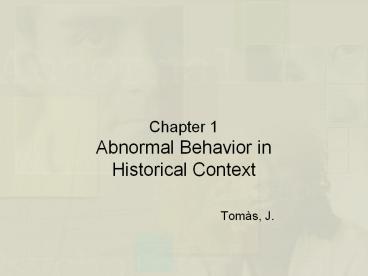Chapter 1 Abnormal Behavior in Historical Context Tom - PowerPoint PPT Presentation
1 / 20
Title:
Chapter 1 Abnormal Behavior in Historical Context Tom
Description:
... Abnormal Behavior and the Psychoanalytic Tradition Freudian Theory of the Structure and Function of ... Freud Carl Jung ... Carl Rogers Major Theme That ... – PowerPoint PPT presentation
Number of Views:172
Avg rating:3.0/5.0
Title: Chapter 1 Abnormal Behavior in Historical Context Tom
1
Chapter 1Abnormal Behavior in Historical
Context Tomàs, J.
2
Toward a Definition of Abnormal Behavior
- Psychological Dysfunction
- Breakdown in cognitive, emotional, or behavioral
functioning - Distress or Impairment
- Difficulty performing appropriate and expected
roles - Impairment is set in the context of a persons
background - Atypical or Unexpected Cultural Response
- Reaction is outside cultural norms
3
Abnormal Behavior Defined
- A Psychological Dysfunction Associated With
Distress or Impairment in Functioning That is not
a Typical or Culturally Expected Response - Psychological Disorder and Psychological
Abnormality are Used Interchangeably - Mental Illness is a Less Preferred Term
- Psychopathology is the Scientific Study of
Psychological Disorders
4
Scientist-Practitioner andClinical Description
of Abnormality
- Begins with the Presenting Problem
- Description Aims to
- Distinguish clinically significant dysfunction
from common human experience - Describe Prevalence and Incidence of Disorders
- Describe Onset of Disorders
- Acute vs. insidious onset
- Describe Course of Disorders
- Episodic, time-limited, or chronic course
5
The Past Historical Conceptions of Abnormal
Behavior
- Major Psychological Disorders Have Existed
- In all cultures
- Across all time periods
- The Causes and Treatment of Abnormal Behavior
Varied Widely - Across cultures
- Across time periods
- Particularly as a function of prevailing
paradigms or world views - Three Dominant Traditions Include Supernatural,
Biological, and Psychological
6
The Past Abnormal Behavior and the Supernatural
Tradition
- Deviant behavior was believed to be caused by
demonic possession, witchcraft, sorcery - Mass hysteria (St. Vitusdance or Tartanism) and
the church - Treatments included exorcism, torture, beatings,
and crude surgeries - Movement of the Moon and Stars as a Cause of
Deviant Behavior - Paracelsus and lunacy
- Both Outer Force Views Were Popular During the
Middle Ages - Few Believed That Abnormality Was an Illness on
Par With Physical Disease
7
The Past Abnormal Behavior and the Biological
Tradition
- Hippocrates Abnormal Behavior as a Physical
Disease - Somatogenesis
- Psychogenesis
- Galen Extends Hippocrates Work
- Humoral theory of mental illness
- Treatments remained crude
- Galenic-Hippocratic Tradition
- Foreshadowed modern views linking abnormality
with brain chemical imbalances
8
The Past The Biological Tradition Comes of Age
- General Paresis (Syphilis) and the Biological
Link With Psychosis - Pasteur discovered the cause A bacterial
microorganism - Led to penicillin as a successful treatment
- Bolstered the view that mental illness physical
illness and should be treated as such
9
The Past Consequences of the Biological
Tradition
- Mental Illness Physical Illness
- The 1930s Biological Treatments Were Standard
Practice - Insulin shock therapy, ECT, and brain surgery
(i.e., lobotomy) - By the 1950s Several Medications Were
Established - Examples include neuroleptics (i.e., reserpine)
and major tranquilizers
10
The Past Abnormal Behavior andthe
Psychological Tradition
- The Rise of Moral Therapy
- The practice of allowing institutionalized
patients to be treated as normal as possible and
to encourage and reinforce social interaction - Philippe Pinel and Jean-Baptiste Pussin
- Reasons for the Falling Out of Moral Therapy
- Emergence of Competing Alternative Psychological
Models - Dorothea Dix
11
Before Freud
- Mesmer hypnosis
- Charcot
12
The Past Abnormal Behavior andthe
Psychoanalytic Tradition
- Freudian Theory of the Structure and Function of
the Mind - The Minds Structure
- Id (pleasure principle illogical, emotional,
irrational) - Ego (reality principle logical and rational)
- Superego (moral principles keeps Id and Ego in
balance)
13
Defense Mechanisms
- When the Ego Loses the Battle with the Id and
Superego - Displacement denial
- Rationalization reaction formation
- Projection, repression, and sublimation
14
Freudian Stages of Psychosexual Development
- Oral, anal, phallic, latency, and genital stages
- Personality Traits
15
From Psychoanalytic Thought toPsychoanalysis in
Therapy
- Unearth the Hidden Intrapsychic Conflicts (The
Real Problems) Neurotic Anxiety - Techniques Include Free Association and Dream
Analysis - Examine Transference and Counter-Transference
Issues
16
Later Neo-Freudian Developmentsin Psychoanalytic
Thought
- Others Developed Concepts Different from Those of
Freud - Carl Jung
- Collective Unconscious
- Masculine vs. Feminine
- Introversion vs. Extroversion
- Meaning of Life
- Alfred Adler
- Inferiority
- Strive for Superiority
- Individual Psychology
- The Neo-Freudians Generally De-emphasized the
Sexual Core of Freuds Theory
17
Humanistic Theory and the Psychological Tradition
- Carl Rogers
- Major Theme
- That people are basically good
- Humans strive toward self-actualization
- Treatment
- Therapist conveys empathy and unconditional
positive regard
18
The Behavioral Model and the Psychological
Tradition
- Derived from a Scientific Approach to the Study
of Psychopathology - Ivan Pavlov, John B. Watson, and Classical
Conditioning - Classical conditioning is a ubiquitous form of
learning - Conditioning involves correlation between neutral
stimuli and unconditioned stimuli - Conditioning was extended to the acquisition of
fear - Edward Thorndike, B. F. Skinner, and Operant
Conditioning - Another ubiquitous form of learning
- Most voluntary behavior is controlled by the
consequences that follow behavior - Both Learning Traditions Greatly Influenced the
Development of Behavior Therapy
19
From Behaviorism to Behavior Therapy
- Reactionary Movement Against Psychoanalysis and
Non-Scientific Approaches - Early Pioneers
- Joseph Wolpe Systematic desensitization
- Counterconditioning
20
The Present The Scientific Method andan
Integrative Approach
- Psychopathology Is Multiply Determined
- One-dimensional Accounts of Psychopathology Are
Incomplete - Must Consider Reciprocal Relations Between
- Biological, psychological, social, and
experiential factors - Defining Abnormal Behavior Is Also Complex, and
Multifaceted, and Has Evolved - The Supernatural Tradition Has No Place in a
Science of Abnormal Behavior






























